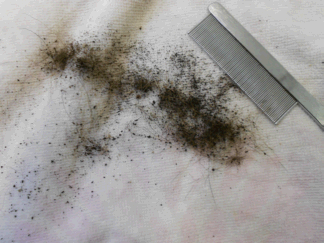|
BARTONELLA AND CAT SCRATCH DISEASE

|

Ted Nugent in concert.
(Photocredit: Public Domain Graphic
via Wikimedia Commons)
|
Ted Nugent made Cat Scratch Fever (actually called “Cat Scratch Disease”) nearly a household name with his song in the late seventies but most people still know very little about this infection other than it involves a fever spread by cat scratches. In fact, it involves infection by bacteria of the genus "Bartonella." There are 24 Bartonella species, 14 of which can infect humans and five of which are harbored by cats. The five Bartonella species harbored by cats are spread by fleas. The most well studied and most common Bartonella organism is Bartonella henselae. Classically, cats transmit the organism when they are parasitized by fleas, scratch themselves, and get infected flea dirt (digested host’s blood excreted by fleas) in their claws, and scratch a person (or another cat) with their dirty claws.
|

Bartonella organism
(Photocredit: Public Domain Graphic
via Wikimedia Commons)
|
|

Flea dirt looks like black specks in the pet’s fur. On
close inspection some of the specks are comma shaped.
The “dirt” is actually flea excrement consisting of
dried blood from the host. The flea dirt drops
from the coat along with flea eggs (which are white).
The newly hatched flea larvae consume the flea dirt as food.
(original graphic by marvistavet.com)
|
THE HUMAN DISEASE
Infection with Bartonella henselae in the immunocompetent person (i.e., a normal person) leads to “cat scratch disease.” The inoculation site (a scratch from a claw containing bits of flea dirt) develops a small red bump (a “papule.”) About 2-3 weeks following contact with the infected cat, the lymph node in the area of the contact will swell and become painful and a fever develops. These signs generally resolve on their own and the condition is minor though lymph node enlargement can persist for several months.
If the patient does not have a competent immune system (in other words, they are very old, very young, debilitated from another condition etc.), one of several much more serious syndromes can result. The infection goes deeper into the body causing spleen enlargement, and potentially encephalitis, heart valve infection, and other conditions. These syndromes are still rare even in people who are immunocompetent but they are potentially very serious.
For more detail on the Cat Scratch Disease in humans we recommend:
|
HOW LIKELY IS IT FOR A CAT TO BE INFECTED?
|

(photocredit: MorgueFile.com)
|
Since fleas carry the bacteria, cats with insufficient flea control are at highest risk. This means cats living in climates that are warm and humid (conditions where fleas thrive best) are most likely to be infected. If conditions are right, up to 40% of cats in an area may be infected. If a person is diagnosed with cat scratch disease, there is a 90% chance that the cats they own will be found infected as well.
This sounds somewhat concerning for the cat-owners in a flea area but it is important to realize that an infected cat cannot transmit the infection without a claw full of flea dirt. If the fleas are removed from the infected cat, there will be no flea dirt in the coat and no risk of disease transmission. Experimental studies have not been able to demonstrate cat to cat transmission in cats that mutually groom each other, fight with each other, mate with each other, or share food or litter with each other nor has transmission been demonstrated between infected mother cats and their kittens. Short of an actual blood transfusion with an infected cat, fleas (or ticks) are needed to spread the infection.
|
DO INFECTED CATS GET SICK?
|
This is a highly controversial question. It was only relatively recently discovered (1992) that cats themselves were more than simple carriers of Bartonella henselae and that they could actually become infected themselves. Several illnesses seem to have been associated with Bartonella infection (fever, deep eye inflammation, lymph node enlargement, muscle pain, reproductive failure, and bacterial heart valve deposits called “endocarditis") but these seem to be isolated cases for the most part. The Bartonella organisms are highly adapted to live in the feline body without causing disease and it is only in rare situations that cats actually experience issues from this infection.
It has been suggested that Bartonella infection may be at the root of numerous chronic inflammatory conditions of the cat. With such high numbers of infected cats present regionally (up to 40%), it is going to be difficult to prove one way or the other whether there is a real association or just coincidence.
|

(photocredit: MorgueFile.com) |
IS MY CAT INFECTED?
First of all, testing is not recommended for the average cat even if the cat is sick. Testing would be a good idea for any cat that may become a blood donor, for the rare sick cat where Bartonella-related disease is actually being considered, if a human in the home has been diagnosed with a Bartonella-related disease, or if there is an immune-compromised person in the home (in which case testing is actually important).
There are 5 tests available to detect Bartonella henselae: ELISA, IFA, PCR, Culture, and Western Blot. All the tests have pros and cons and no method seems to shine above the others.
The ELISA, IFA, and Western Blot tests are tests for antibody detection, the idea being that if antibodies against Bartonella are present then Bartonella must be present as well. For most diseases where antibody levels are used to establish a diagnosis, a mimimum “titer” or antibody amount is considered necessary to say “yes, this patient is infected.” A problem with this is that we know that up to 11% of cats with Bartonella organisms happily circulating in their bloodstreams will not make antibodies and will thus test negative. At least this means that when the test is negative there is an 89% or greater chance that the cat is truly negative. For screening, this kind of antibody testing is frequently paired with PCR testing.
PCR is a very sensitive DNA test for Bartonella but because the organism only intermittently circulates, false negatives can result if not very much Bartonella DNA is circulating. Results from PCR testing can rapidly distinguish different species of Bartonella.
The most reliable test is the blood culture; however, several consecutive cultures are needed because of the problem of the organism tending to only circulate intermittently. A positive culture is proof of infection though a negative culture may simply not have been taken at the time when organism is circulating.
In humans, a delayed hypersensitivity skin test is used as part of the diagnostic criteria for Cat Scratch Disease but this test has not been useful in cats. In this test, similar to the Tuberculosis test most of us are familiar with, a scratch on the skin is made and a reaction to the introduced antigens may occur either right away or in approximately 48 hours (delayed hypersensitivity reaction). Cats are poor delayed hypersensitivity responders.
All in all, it is very hard to rule out a cat as a carrier of a Bartonella organism. If results of testing are suggestive of infection, treatment can be considered if the cat is truly believed to have illness from the infection or if there is realistic concern about human exposure (immune compromised individual).
TREATMENT OF THE CAT
An assortment of antibiotics have been used against Bartonella henselae in cats: clavulanic acid-amoxicillin combination, azithromycin, doxycycline, and quinolone class medications (enrofloxacin, marbofloxacin, etc). Efficacy has been mixed and Bartonella henselae rapidly becomes resistant to therapy. Treatment is currently recommended for cats showing symptoms of disease or for cats living with immune-compromised individuals. Treatment lasts a minimum of 3 weeks.
GUIDELINES FOR PREVENTION OF HUMAN INFECTION:
The following guidelines have been published by both the CDC and the European Advisory Board on Cat Diseases:
- Immune-suppressed people should adopt only apparently healthy cats greater than 1 year of age.
- Immune-suppressed people should not adopt from the shelter or from multi-cat homes.
- Cats belonging to immune-compromised people should be kept indoors only and should not have contact with cats that go outdoors.
- Claws should be kept trimmed.
- Cat scratches should be promptly washed. (This goes for everyone, not just immune-compromised people)
- Flea control should be strict.
CAN DOGS GET INFECTED?
|

(photocredit: MorgueFile.com)
|
The short answer is: yes though the species of Bartonella they get is Bartonella vinsonii rather than Bartonella henslae. Fleas may carry the infection as they do for cats plus it appears that ticks may also be carriers. Since there are numerous infectious agents spread by ticks and it is not unusual for a dog to have multiple tick-borne infections it is very difficult to determine which infection is causing which signs.
|
FURTHER REFERENCES
www.webmd.com/skin-problems-and-treatments/cat-scratch-fever
http://www.cdc.gov/

Page last updated: 8/8/2019
|